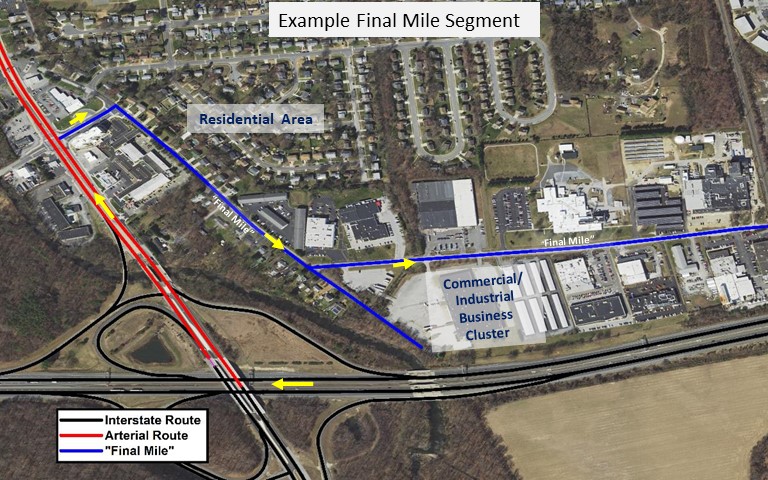Freight First/Final Mile Network Development Study
2025 Update & Application of the First/Final Mile Freight Network
This effort is designed develop a comprehensive statewide first/final mile roadway inventory to help further an understanding of the locations, their roles in the overall transportation system, and develop better transportation and land use practices to address first/final mile facilities in the County. It performed a two-part analysis that addresses localized freight impacts around the New Castle County’s first/final mile freight connections:
| Part 1: Perform a technical update to the 2021 first/final mile network as recommended in the 2022 Delaware State Freight Plan and will reassess the network criteria to incorporate any recent demographic, policy, data, or traffic conditions. |
| Part 2: Perform a technical review of the network versus relevant policy documents and other plans produced by DelDOT, WILMAPCO and New Castle County, capturing the guiding principles outlined in the original study to develop solutions to help manage/protect/accommodate conflict points between goods movement and other land uses. |
| 2025 Update Meetings, Presentations and Other Development Materials | ||
|
||
2021 Network Development Materials
| 2021 Network Document | Focus Group Meetings and Other Materials | |
What is a First/Final Mile Road Network???
First/final mile roadways are critical elements of the freight transportation system because they link freight facilities with major corridors for regional and inter-state travel such as I-95, and US-13. Since first/final mile roadways serve as connectors to major corridors, they are often very short road segments along lower functionally-classified routes that also support multiple users including passenger vehicles, bicycles, and pedestrians, and may not have been designed to easily accommodate truck traffic.
Some commonly-observed problems on first/final mile routes across the US and Delaware include:
Scroll to see more
| Mobility Concerns | Safety Concerns | Road Conditions | Land Use Conflicts |
|
|
|
|
How important are they to our economy?
The first/final mile freight network is among the most misunderstood portions of transportation networks, even among industry professionals. Overall, these facilities are often lower functionally classified routes (i.e local or collectors) on which freight/passenger vehicle conflicts are more visible and a negative public perception of truck traffic may be much greater. These locations also tend to be near residential areas, so they can create a conflict between freight mobility and other users of the transportation system. These types conflicts can negatively impact the safe and efficient movement of freight.
Other Freight Links
- 2019 Interstate Truck Travel Time Reliability (Interactive Map)
- Delaware Primary Freight Network (PFN) (Interactive Map)
- 2019 Delaware Freight Bottlenecks: (Interactive Map)
- 2019 Freight Bottlenecks and Improvements Summary (PDF: Updated 2/5/20)
- 2017 Delmarva Freight Plan Addendum

Sign up for Project Updates!
- We welcome your feedback! If you have questions or comments or would like to sign up for project email updates, please email Dawn Voss at dvoss@wilmapco.org.
- For any questions or comments, please email the project manager Dan Blevins at dblevins@wilmapco.org

